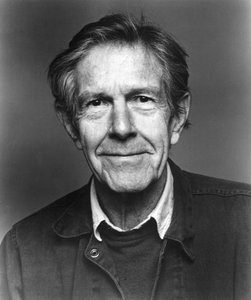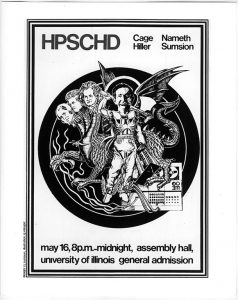Previous “Fine…” Tour Stop | Return to “Fine…” Tour Map | Next “Fine…” Tour Stop

John Cage, an influential twentieth century composer and writer, was born on September 5,1912 in Los Angeles, California. From an early age, Cage sought to be a creator. At Age 9, he learned piano. His real passion, however, came from writing. His passion for writing led him to Pomona College. Lack of inspiration as a writer led Cage to drop out of Panoma after two years.
After leaving Pomona college, Cage traveled to Europe. While exploring France, Germany, Spain and Italy, Cage discovered an interest in Johann Sebastian Bach and Igor Stravinsky. This discovery sparked a desire to compose music. After brief, yet eye-opening, travels in Europe, Cage moved to NYC to take classes at The New School. At the New School in New York, Cage studied Composition and networked within the avant-garde music scene.
This time marked an era for Cage’s personal growth. Cage discovered Zen Buddhism, Indian music and Chinese Philosophy. These explorations deeply influenced Cage’s work, especially within his use of chance and sound randomness in music performance.
Prior to his appointment at Illinois, Cage collaborated with other artists at Black Mountain College, an extremely influential experimental art school that produced the leading artists of the mid twentieth century such as Robert Rauschenberg and Merce Cunningham. Black Mountain College provided Cage the opportunity to be a primary contributor to the Neo-Dada art movement.

In 1967, Cage left New York for a visiting professor position at the University of Illinois Urbana-Champaign. Cage’s partner Merce Cunningham also had several visiting positions with the university before. Cage worked diligently at the University through 1969, culminating with his most known composition: HPSCHD. This was an involved multimedia composition. Working in collaboration with Lejaren Hiller, Calvin Sumsion and Ron Nameth, HPSCHD incorporated static visuals, film components, and complex technical programming.
HPSCHD linked the gap between technology and art on a grand scale. A theatrical display of 8000 slides, 40 films, 52 computer-produced tones, and seven harpsichords commented upon the happenings of the late ‘60s: counterculture, political insubordination, postmodern philosophical movements and the growth in technology.
Cage’s first composition at the University of Illinois though was Musicircus. This event was part of a series of “happenings” in 1967. It took place in the Stock Pavilion on campus an had a circus theme, complete with a popcorn machine. Artists all performed at the same time, some on elevated platforms.

Cage went on to create after his time at Illinois. Most notably, his Number Pieces (1987-1992) composed in the six years leading up to his death mark his prolific career as an influencer of postmodern music, ambiance, multimedia exploration, and the use of technology for art’s sake. Each number represents the number of performers in each work of the series, such that no. 7 consists of seven members.
– State Farm Center. Assembly Hall (now the State Farm Center) is where HPSCHD took place.
– Stock Pavilion. Located on the South Quad, this is where Cage performed
John Cage at UIUC. (n.d.). Retrieved from https://www.library.illinois.edu/mpal/about/exhibits/johncage/
John Cage Biography, Art, and Analysis of Works. (n.d.). Retrieved from http://www.theartstory.org/artist-cage-john.htm
John Cage Performance. (1967, Nov. 17). Illinois Alumni News. Record Series 39/2/20, Box 126 EVE, Folder EVE – 14. University of Illinois Archives.
John Milton Cage Jr.jpg. (2018, April 27). Wikimedia Commons, the free media repository. Retrieved from https://commons.wikimedia.org/w/index.php?title=File:John_Milton_Cage_Jr.jpg&oldid=298753247.
Heimbecker, S.J. (2011, May 01). John Cage’s HPSCHD. Retrieved from https://www.ideals.illinois.edu/handle/2142/24332
HPSCHD Event Poster (1969, May). Photographic Subject File, 1868-. Record Series 39/2/20, Box MUS 11, Folder MUS 11 Instrumental Performers 1930-. University of Illinois Archives.
